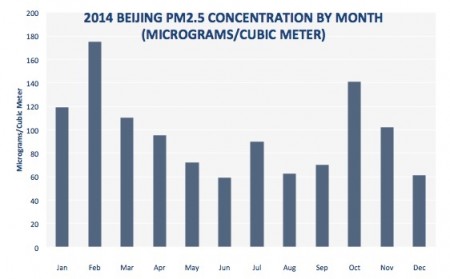By Anders Hove

(Note: 2008 data from March; 2014 data through Dec. 16)

(Note: December data through Dec. 16)
Has China made progress on air pollution in 2014? The charts seem to show that Beijing’s air quality got just a tiny bit better. But data for the year indicate that the average Beijing PM2.5 concentration in 2014 was in line with the prior five-year average—indicating minimal progress toward the city’s goal of reaching an annual average of 60 micrograms/m3 in ambient PM2.5, or toward the Beijing-Tianjin-Hebei (JJJ) target of a 25% reduction in the region’s annual average ambient PM2.5 by 2017.
The result highlights the need for a more integrated, long-term approach. Beijing suffered a particularly nasty autumn in 2014, with long periods of intense haze matching the January 2013 “Airpocalypse” conditions in intensity and duration—including during the Beijing marathon in October. During the November APEC conference, the government swung into action with a set of drastic policies to reduce pollution, limiting driving, announcing spur-of-the-moment holidays, and shutting factories in cities across a half-dozen provinces surrounding Beijing. The bad news is that the measures drastically hit the economy, while only cutting pollution by around 30%. Beijingers even coined new tongue-in-cheek lingo during the event: “Apec Blue” has come to mean something good that cannot last. In the end, pollution levels during a couple days of the conference were severe enough that Beijing opted to censor apps providing real-time AQI readings from the U.S. embassy.
Fortunately, China is working on long-term approaches. Beijing, Tianjin and Hebei have all created action plans with important policies, including caps on coal consumption and closure of outdated industry, that should have a major impact on pollution. Equally important, the government is working with a variety of organizations, including the Paulson Institute, to study how the Beijing-Tianjin-Hebei region can speed its transformation towards a cleaner, more prosperous economy.
Anders Hove is Associate Director for China Research at the Paulson Institute.


